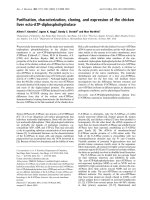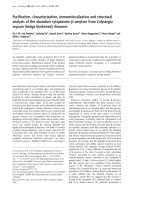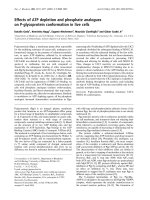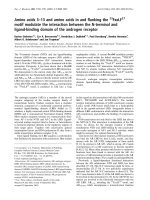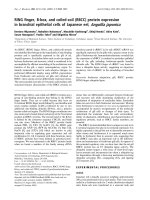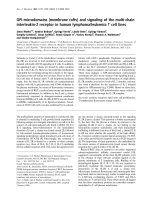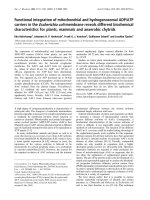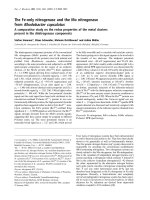Báo cáo y học: "HAE therapies: past present and future" ppsx
Bạn đang xem bản rút gọn của tài liệu. Xem và tải ngay bản đầy đủ của tài liệu tại đây (264.92 KB, 8 trang )
REVIE W Open Access
HAE therapies: past present and future
Bruce L Zuraw
Abstract
Advances in understanding the pathophysiology and mechanism of swelling in hereditary angioedema (HAE) has
resulted in the development of multiple new drugs for the acute and prophylactic treatment of patients with HAE.
This review will recap the past treatment options, review the new current treatment options, and discuss potential
future treatment options for patients with HAE.
Introduction
Hereditary angioedema with reduced C1 inhibitor func-
tion (HAE) is an autosomal dominant disease character-
ized by recurrent episodes of potentially life- threa tening
angioedema. The pathophysiology of HAE as well as the
molecular mechanisms underly ing attacks of swelling in
HAE have been gradually dissected over the past 50
years [1-3]. These advances have led to a rapidly chan-
ging set of therapeutic options for patients with HAE.
HAE patients typically begin to swell in childhood,
and often suffer increased symptoms about the time of
puberty, and continue to experience recurrent attacks of
ang ioedema throughout the remainder of their lives [4].
Attacks of angioedema in HAE can be severe and pro-
longed, typically lasting 3-5 days before the patient is
well again. Abdo minal attac ks may result in hospitaliza-
tion and all to often lead to inappropriate intra-abdom-
inal surgery, while oro-pharyngeal-laryngeal attacks can
be life-threatening [4-6]. Despite striking advances in
medical knowledge, HAE patients continue to die from
laryngeal attacks [7,8]. The disease thus imposes an
enormous burden on patients as well as their families,
often preventing them from leading a productive life.
Because of the significant morbidity and mortality
associated with HAE, careful management of these
patients is essential. The management of HAE required
attention to three areas: treatment of acute episodes of
angioedema, long-term prophylaxis, and short-term pro-
phylaxis [4,5,9,10]. To help the clinician n avigate the
changing therapeutic landscape, this article will review
the past, current, and futu re options for treating HAE
patients in the United States.
HAE treatment: The past
Treatment of acute HAE attacks
Attacks of angioedema in patients with HAE involve
subcutaneous tissues (primarily involving extremities,
genitalia or the face), t he intestine, and the respiratory
tract. Attacks typically but not invariably follow a trajec-
tory in which the angioedema increases for 24 hours
then slowly decreases over the following 48-72 hours.
Importantly, the swelling in HAE attacks does not
respond reliably to the drugs em ployed in treating other
forms of urticaria/angioedema such as anti-histamines,
epinephrine, or corticosteroids. While epinephrine, in
particular, may have a transient effect on swelling, it
does not alter the course of the attack.
Until late 2008, there was no drug approved in the
United States that was predictably effective for the treat-
ment of acute attacks of HAE. Anecdotal and published
experience suggests that administration of fresh frozen
plasma can abort ongoing HAE attacks by replacing
plasma C1 inhibitor (C1INH) levels [11]. There is, how-
ever, a theoretic and demonstrated risk that fresh frozen
plasma can worsen acute swelling, possibly due to
replenishment of plasma proteases and substrates
involved in the generation of peptides that mediate the
angioedema [12,13]. Epsilon aminocaproic acid (Ami-
car
™ ) has also been used intravenously for acute epi-
sodes of angioedema, and anecdotal reports suggest that
it may be minimally helpful; however, there is no pub-
lished evidence demonstrating that it provides signifi-
cant benefit. Anabolic androgens, which are effective
prophylactic agents (see below) require at least 1-2 days
before they begin to be effective, and are therefore not
useful in the acute treatment of attacks.
The management of acute attacks was thus primarily
concerned with symptomatic control of the swelling.
Correspondence:
Department of Medicine, University of California San Diego and San Diego
Veteran’s Affairs Medical Center, La Jolla, CA, USA
Zuraw Allergy, Asthma & Clinical Immunology 2010, 6:23
/>ALLERGY, ASTHMA & CLINICAL
IMMUNOLOGY
© 2010 Zuraw; licensee BioMed Centra l Ltd. This is an Open Access article distributed under the terms of the Creative Commons
Attribution License ( licenses/by/2.0), which permits unrestricted use, distribution, and reproduction in
any medium, provided the original work is properly cited.
Abdominal attacks often present with severe pain and
nausea as well as significant dehydration, sometimes
accompanied by significant hypotension. Management of
these attacks involved aggressive intravenous replace-
ment of fluid as well as control of pain and nausea with
parenteral narcotic and antiemetic drugs. Oropharyngeal
attacks may lead to death secondary to asphyxiation,
and therefore required hospitalization for careful moni-
toring of airway patency. If the airway was threatened,
the patient needed to be intubated by an experienced
physician with the capability for emergency tracheotomy
immediately available. Acute angioedema of the extremi-
ties does not typi cally require treatment, although
angioedema of the feet or dominant hand can be tem-
porarily disabling.
Long-term prophylaxis
The goal of long-term prophylaxis is to decrease the fre-
quency and/or severity of swelling attacks. The fre-
quency and severity of angioedema attacks is highly
variable among HAE patients, ranging from attacks
occurring as often as twice per week to patients who are
asymptomatic. Most untreat ed HAE patients will swell
approximately one to two times per month on average.
While some HAE patients may not require long-term
prophylactic therapy, patients with frequent attacks or
with a history of serious attacks involving the upper air-
way should be treated prophylactically. In general
patients with significant s welling occurring more fre-
quently than once every 3 months are considered candi-
dates for long-term prophylactic therapy, although it is
the impact of the episodes on the patient’ s ability to
lead a normal life that is the deciding factor. Other con-
sid erations that shoul d go into this decision include the
location of attacks (airway attacks causing increased
concern) and the accessibility of the patient to appropri-
ate medical care. Because of their ability to increase bra-
dykinin-mediated effects, angiotensin-converting enzyme
inhibitors need to be avoided in HAE patients. Birth
control pills and hormonal replacement therapy also fre-
quently exacerbate disease severity in women [14].
Two modalities of treatment were available for long-
term prophylaxis: anabolic androgens and ant i-fibrinoly-
tics. The best tolerated and most effective long-term
prophylactic drugs are the synthetic anabolic androgens
which increase C1INH plasma levels and decrease
attacks of HAE [15]. The 17-a-alkylated androgens are
orally available and were the drugs of choice for the
long-term prophylaxis of HAE. Danazol and stanozolol
are synthetic 17-a-alkylated androgens that are widely
used for this purpose and are less virulizing than
methyltestosterone. Oxandr olone, a 17-a-al kylated
androgen that is approved for treatment of acquired
immunodeficiency syndrome wasting syndrome in chil-
dren, has also been successfully used to treat HAE [16].
The precise mechanism by which anabolic androgens
increase C1INH levels has not be elucidated [17]; but
the dose of anabolic androgen should not be based on
the C1INH response. The dose of anabolic androgens
used to treat HAE should be titrated down to find the
lowest dose which confers adequate prophylaxis, typi-
cally 2 mg stanozolol daily or every other day or 200 mg
danazol daily or every other day. Detailed recommenda-
tions for dose titration have been published [18].
The side effects of anabolic androgens are dose
related, with the most important side effects being hepa-
totoxicity and virulization [19]. Most HAE patients tol-
erate anabolic androgens at the doses described above,
however sustained use at h igher doses often result in
significant side effects. Patients taking anabolic andro-
gens should have their liver enzymes checked every 6
months. Evidence of hepatic injury should precipitate
tapering or discontinuation of the drug, with documen-
tation of normalization of the hepatic tests. Since hepa-
tic adenomas have been reported as a consequence of
anabolic androgens [20], ultrasound examination of the
liver is warranted in the presence of persistently elevated
liver enzymes.
The antifibrinolytic drugs epsilon aminocaproic acid
(EACA or Amicar) and tranexamic acid are frequently but
not always effective in preventing angioedema attacks in
HAE [21-23]. The mechanism of their efficacy in HAE is
unknown. Because the anabolic androgens are more reli-
ably effective for the control of HAE, they were generally
used in preference to antifibrinolytics in adult patients
with the antifibrinolytic drugs often reserved for patients
who didn’t tolerate anabolic androgens. Because anabolic
and rogens may interfere with normal sexual maturation,
antifibrinolytics have been preferred over androgens in
children and pregnant women. Tranexamic acid is not
currently available in the United States. The typical thera-
peutic dose of EACA is 1 gm orally 3-4 times per day.
The treatment of pregnant wome n and children pre-
sented particular difficulties. Androgens are contraindi-
cated in these populations due to their potential effects
on growth and sexual maturation. Angioedema fre-
quency may not change or may decrease during preg-
nancy; however, some women experienc e an increase in
attacks during pregnancy. Remarkably, almost all
women are protected f rom swelling during l abor and
delivery.
Short-term prophylaxis
Short-term prophylaxis should be used to prevent
attacks of angioedema when the patient is at high risk
of swelling, particularly before expected trauma such as
surgery or dental procedures. To avoid potentially cata-
strophic swelling, it is critically important that all HAE
patients be made aware of the need for short-term pro-
phylaxis in these situations.
Zuraw Allergy, Asthma & Clinical Immunology 2010, 6:23
/>Page 2 of 8
High-dose anabolic androgen therapy (stanozolol 2 mg
three times daily or danazol 200 mg three times daily)
begun 5 to 7 days before the procedure affords reason-
able protection in most patients [18]. Alternatively, the
patient can be infused with two units of fresh frozen
plasma several hours before the procedure [24].
HAE treatment: The present
Over the past 18 months, 3 new medications for the
treatment of HAE have been approved for use in the
United States. Two of these medications are C1INH
concentrates and the third is a plasma kallikrein inhibi-
tor. Each of these is discussed below.
Plasma-derived C1INH concentrates
The pathophysiologic basis of HAE was demonstrated to
be a deficiency of C1INH in 1963 by Virginia Donaldson
[1], clarifying the lack o f kallikrein inhibitory activity i n
HAE patient plasma observed the year before by Land-
erman et al [25]. The rationale for replacement therapy
was established by the success of administering fresh
frozen plasma (FFP) during acute attacks of HAE [11].
Beginning in the late 1970s, a number of investigators in
Europe and the United States began demonstrati ng that
replacement therapy with C1INH concentrates was
effective in HAE.
Over the past 25 years, multiple studies have con-
firmed the efficacy of plasma C1INH as replacement
therapy for acute attacks of HAE [26-32]. Clinically,
symptomatic improvement is typically seen within 30-60
minutes of drug administration [33]. Furthermore,
C1INH concentrates appear to be equal efficacy for all
types of HAE attacks - including laryngeal attacks where
it can be life-saving [31]. C1 inhibitor concentrates have
also been successfully used for both short-term [34-37]
and long-term prophylactic treatment of HAE [38-40].
C1INH concentrate became the preferred modality of
treatment for acute attacks of HAE in some countries
where it is available.
In 1996, Waytes et al [41] published the results of two
double-blind placebo-controlled studies c omparing
plasma derived C1INH (25 plasma units/kg; Immuno
AG) to placebo. The first was a crossover study invol-
ving prophylactic treatment of 6 severely affected HAE
patients who received study drug every three days. Dur-
ing the periods that they received C1INH, subjects
increased their plasma C1INH functional levels, normal-
ized their C4 titers and had significantly less swelling
than they did during the period they rece ived placebo.
The second study assessed the time to improvement fol-
lowing study drug in 22 patients with acute attacks of
HAE. The beginning of relief occurred significantly fas-
ter in C1INH treated patients than in placebo treated
patients (55 versus 563 minutes). However, a pivotal
phase III trial of the Immuno C1INH concentrate
(Baxter Healthcare) for acute HAE attacks failed to
show any improvement in C1INH-treated compared to
placebo-treated subjects. Two plasma-derived C1INH
products underwent Phase 3 randomized clinical trials,
and were recently approved for use in the United States.
Pasteurized plasma-derived C1INH concentrate
Berinert (C SL Behring) is a pasteurized lyophi lized
human plasma-derived C1 inhibitor concentrate for
intravenous injection. It has been licensed in Europe
(Germany, Austria, and Switzerland) for over 20 years,
and is also available in Canada. Numerous reports of
the efficacy and safety of Berinert have been published
(reviewed in [39]). A phase III study of Berinert for the
treatment of acute attacks of HAE was recently com-
pleted [42]. This study compared the efficacy (shorten-
ing onset of relief of symptoms) of 2 doses of Berinert
(10 U/kg and 20 U/kg) to placebo in 125 HAE patients
with moderate to severe abdominal or facial angioedema
attacks. Compared to the placebo treated group, subjects
receiving 20 U/kg of Berinert-P showed a significant
reduction in the median time to onset of relief of symp-
toms of HAE attacks compared to placebo (0.5 versus
1.5 hours, p = 0.0025). Median time to complete resolu-
tion of all HAE symptoms was also significantly shorter
in the 20 U/kg group compared to the control group
(4.92 versus 7.79 hours, p = 0.0237). At a dose of 10 U/kg,
the median time to onset of relief was 1.2 hours, which
was not significantly different than the placebo group.
Based on the data from this study, Berinert received
approval from the FDA for use in the treatment of
acute angioedema attacks in adolescent and adult HAE
patients.
Nanofiltered and pasteurized plasma-derived C1INH
concentrate
Cinryze (ViroPharma Incorpo rated) is a nanofiltered
pasteurized C1INH concentrate for intravenous use.
Cinryze is manufactured by Sanguin in the Netherlands,
using U.S. plasma. The manufactur ing process is identi-
cal to that used for the existing Cetor C1INH product,
except that Cinryze is subjected to a final nanofiltration
step, which provides additional protection against envel-
oped and non-enveloped viral particles and possibly
prions [43]. Two separate randomized double-blind pla-
cebo controlled studies of Cinryze have been performed
in the United States [44].
The first study assessed efficacy and safety of C1INH-
nf for the treatment of moderate to severe acute attacks
of facial, abdominal or genitourinary angioedema in
HAE patients [45]. Subjects were infused with study
drug (C1INH-nf 1,000 IU or placebo) at time 0. If
significant relief was not reported within 60 minutes,
subjects were then given a second dose of the same
study drug they received initially. All subjects were
eligible to receive open-label Cinryze after 4 hours. In
Zuraw Allergy, Asthma & Clinical Immunology 2010, 6:23
/>Page 3 of 8
68 randomized eligible attacks, the estimated time to
beginning of unequivocal relief (primary endpoint) was
significantly shorter in the C1INH group (median
time 2 hours) than in the placebo group (median time
> 4 hours) (p = 0.026). Cinryze treated patients also
showed a statistically significant improvement in median
time to complete resolution of the defining symptoms
(p = 0.004). The efficacy of Cinryze treatment did not
vary by attack location.
A second study involved the use of C1INH-nf as long-
term prophylaxis to prevent attacks of angioedema was
also recently completed. Twenty-two patients with a his-
tory of frequent angioedema were treated with C1INH-
nf (1,000 IU) or place bo two times per week for 12
weeks then crossed over and received the other treat-
ment for an additional 12 weeks. During the C1INH-nf
treatment periods, subjects showed a highly significant
(p < 0.0001) decrease in HAE attacks (6.26 versus 12.73
attacks; p < 0.0001).
Cinryze receiv ed FDA approval for prophylactic treat-
ment in adolescent and adult HAE patients. The appli-
cation for use of Cinryze to treat acute attacks of
angioedema is still pending.
Safety and tolerability of plasma-derived C1INH
concentrates
Both Berinert and Cinryze are each derived from U.S.
plasma that has been PCR screened then subjected to
multiple viral inactivation/removal steps, including pas-
teurization. In addition, Cinryze undergoes nanofiltra-
tion, which removes viral- and potentially prion-sized
particles based on size exclusion rather than specific
physicochemical interactions. The results of the studies
described above did not show any evidence of safety or
tolerability issues with either of the drugs.
Plasma kallikrein inhibitor: ecallantide
Unraveling the mechanism of swelling in patients with
HAE has long been considered central to the develop-
ment of more effective treatment strategies. Early
investigations found that incubation of plasma from
HAE patients ex vivo at 37°C generated a factor that
caused smooth muscle contraction and inc reased vas-
cular permeability [46]. This ‘ vascul ar permeability
enhancing factor’ was correctly assumed to be the
mediator of swelling in HAE; however, the final char-
acterization of the factor remained elusive and contro-
versial for many years. Compelling laboratory and
clinical data have conclusively shown that bradykinin
is the primary mediator of swelling in HAE [47-57].
The nanopeptide bradykinin is generated when active
plasma kallikrein cleaves high molecular weight kinino-
gen(HMWK)[58].Thereleasedbradykininmoiety
potently increases vascular permeability by binding to
its cognate receptor (the bradykinin B2 receptor) on
vascular endothelial cells.
The discovery that bradykinin is primarily responsible
for the attacks of swelling in HAE has led to new
therapeutic strategies to treat HAE by preventing brady-
kinin-mediated enhancement in vascular permeability.
Replacement t herapy with C1INH will inhibit both
plasma kallikrein and activated factor XII. Indeed
administration of C1INH concentrate has been shown
to acutely reduce bradykinin levels in patients expe rien-
cing angioedema attacks [53]. Inhibition of plasma kal-
likrein using other non-C1INH drugs is another strategy
that has been used. The first plasma kallik rein inhibitor,
other than C1INH, to be used for the treatment of HAE
was aprotinin (Trasylol
®). This protein is a broad-
spectrum Kunitz-type serpin inhibitor with activity
against trypsin, plasmin and plasma kallikrein. While
aprotinin was effective in halting acute attacks of HAE
[26,59], this bovine protein was associated with severe
anaphylactic reactions which precluded its use in HAE
management [60,61]. More recently, a specific plasma
kallikrein inhibitor, ecallantide, has been developed.
Ecallantide (Kalbitor, Dyax Inc.) is a novel, potent and
specific plasma kallikrein inhibitor produced in the
Pichia pastoris strain of yeast that was identified using
phage display technology for a library of rationally
designed variants of the first Kunitz domain of human
lipoprotein-associated coagulation inhibitor ( LACI)
[62,63]. The recommended dose of ecallantide t o treat
an angioedema attack is 30 mg, administered as three 1
ml subcutaneous injections. Maximum ecallantide levels
are reached 2-3 hours following subcutaneous injection,
and the half-life is approximately 2 hours [64].
Two separate RDBPC phase III studies of e callantide
for the treatment of acute attacks of HAE have been
performed in the United States. Both studies involved
subjects randomized 1:1 to receive either ecallantide
30 mg or placebo by subcutaneous injection during a
moderate or worse attack at any location. The first trial
(EDEMA3) consisted of 72 patients with the primary
endpoint measured as a treatment outcome score (TOS)
at 4 hours. TOS is a patient-reported measure of
response to therapy using a categorical scale from 100
(significant improvement) to -100 (significant worsen-
ing) for each symptom complex, weighted according to
its baseline severity. Ecallantide-treated patients reported
a mean TOS score of 49.5 ± 59.4 compared to 18.5 ±
67.8 in placebo-treated patients (p = 0.037) [65]. The
improve ment in TOS score was maintained at 24 hou rs
(44.3 ± 70.4 versus -0.5 ± 87.9, p = 0.044).
The second trial (EDEMA4) consisted of 96 pa tients
with the primary endpoint being mean symptom com-
plex severity (MSCS) at 4 hours. The MSCS score is a
patient-reported point-in-time measure of symptom
severity based on s ymptom rating of 0 (none) to 3
(severe) for each potential symptom complex. Severity at
Zuraw Allergy, Asthma & Clinical Immunology 2010, 6:23
/>Page 4 of 8
each time point is the average across all symptom com-
plexes. Ecallantide-treated subjects reported a mean
decrease in symptom score at 4 hours of 0.81 compared
to a decrease of 0.37 in placebo-treated subjects (p =
0.01). At 24 hours, mean symptom scores fell by 1.5 in
the ecallantide-treated s ubjects compared to 1.1 in the
placebo-treated subjects (p = 0.039).
No differences were observed in the response to
ecallantide based on the location of swelling; however
subjects who presented relatively late in the a ttack
(6-8 hours) showed less benefit than those who
presented earlier [66].
Safety is always paramount durin g drug dev elopme nt
and some concerns have arisen regarding the use of
ecallantide. Prolongation of the aPTT is commonly seen,
without any enhanced risk of bleeding. Anaphylactic-like
reac tions have been reported in some subjects following
exposure to ecallantide, including one subject who
experienced a repeat reaction on re-challenge. A single
first dose anaphylactic-like reaction to ecallantide
described serum antibodies to a low molecular compo-
nent of the drug, detected by immunoblotting [67].
Controversy remains as no antibodies were detected by
ELISA screening performed by the manufacturer [68]. A
proportion of patients who receive repeated injections of
ecall antide will develop anti-drug antibodies. A relation-
ship between the presence of anti-drug antibodies and
risk of anaphylactoid reactions has yet to be observed,
and many of the antibody positive subjects have contin-
ued to use ecallantide with good results.
Based on data from both Phase III studies [69],
approval for use of ecallantide to treat acute HAE
attacks in patients aged 16 and over was granted on
December 2 2009. Because of the safety concerns
reviewed above, there is a black box warning on anaphy-
lactic potential and requiring that the drug be adminis-
tered by a health care provider.
Summary of current therapeutic options
The approval of Berinert, Cinryze and ecallantide has
completely changed the therapeutic options available for
the treatment of HAE in the United States. Berinert and
ecallantide are approved for treatment of acu te attacks of
angioedema in HAE. These are the fir st drugs that are
reliably effective f or the acute treatment of HAE attacks.
Whileitmaybetemptingtolimittheuseofthesedrugs
to severe or life-threatening attacks, it is clear that their
efficacy is highest when they are used early in an attack
when it is impossible to predict which attacks are likely
to become severe or life-threatening. In all likelihood,
therefore, these drugs will become the treatment of
choice for acute attacks of angioedema in HAE pa tients.
Long- term prophylaxis will still be important to li mit the
number of attacks needing acute treatment.
Cinryze is approved for HAE prophylaxis rather than
acute treatment. In general, patients with re latively
severe (≥ 2 attacks per month) HAE are potential candi-
dates for prophylactic treatment with Cinryze. While
significantly better than placebo, routine prophylaxis
with Cinryze did not completely abrogate breakthrough
attacks, and it is likely that individualization of the
Cinryze dose or frequency of administration will be
necessary to achieve optimal responses in all treated
patients. It is also likely that low dose anabolic androgen
therapy will continue to be useful in patients who toler-
ate these drugs.
HAE treatment: The future
Two additional novel medications have undergone clini-
cal trials and are p otentially in the pipeline for use to
treat acute attacks of angioedema in HAE patients.
Recombinant human C1INH
Rhucin (Pharming NV) is a recombinant human C1
inhibitor (rhC1INH) concentrate for intravenous infu-
sion isolated from the milk of transgenic rabbits. It is
identical to human plasma derived C1INH at the amino
acid level and demonstrates the same inhibitory profile
as plasma derived C1INH. However, rhC1INH has post-
translational glycosylation differences compared to the
plasma-derived product [70]. A phase I study of
rhC1INH in which the drug was administered to 12
asymptomatic HAE patients at doses ranging from 6.25
to 100 U/kg [71] demonstrated a rapid increase in func-
tional plasma C1INH activity and a corresponding fall
in C4 activation, followed by a slower increase in C4
levels. The half-life of the protein was dose dependent
and was longest at the highest dose used (100 U/kg)
where it was estimated to be 3 hours. The accelerated
clearance of rhC1INH from the plasma space compared
to plasma derived C1INH was presumably influenced by
the glycosylation differences in the recombinant protein.
An open-label phase II study of rhC1INH demonstrated
beginning of relief on average within 1 hour (median
time 30 minutes), with time to minimal symptoms on
average between 6 to 12 hours fol lowing infusion, and
no evidence of late angioedema relapses [72].
Two separate phase III studies have been performed
for rhC1INH in the treatment of acute attacks of
angioedema in HAE patients .
A European randomized placebo-controlled double-
blind clinical study of rhC1INH (100 U/kg) in 32 HAE
patients was stopped on ethical grounds because of a
strong and highly significant positive advantage for
rhC1INH versus placebo in median time to beginning of
relief (62 versus 508 minutes, p = 0.0009) as well as
time to minimal symptoms (480 versus 1480 minutes,
p = 0.0038).
Zuraw Allergy, Asthma & Clinical Immunology 2010, 6:23
/>Page 5 of 8
The phase III study of rhC1INH (100 U/kg and 50 U/
kg) in the United States and Canada in 39 HAE subjects
showed a significant benefit for rhC1INH versus placebo
in median time to beginning of relief (68 minutes for
rhC1INH 100 U/kg, 122 minutes for rhC1INH 50 U/kg,
and 258 minutes for placebo). Time to minimal symp-
toms was also significantly shortened after treatment
with rhC1INH (245 minutes at 100 U/kg and 247 min-
utes at 50 U/kg) compared to placebo (1101 minutes).
There were no significant safety or tolerability issues
reported in these phase III studies. One subject in an
earlier phase study failed to report that she was allergic
to rabbits, and experienced hives and wheezing after
receiving rhC1INH
Icatibant
Another approach to tre ating HAE is by inhibiting the
ability of bradykinin to bind to and signal through its
cognate receptor, the bradykinin B2 receptor. In the
C1INH knockout mouse, blockade of the biologic action
of bradykinin using a bradykinin B2 receptor antagonist
abolished the increased vascular permeability and pro-
vided proof of concept that bradykinin was the medi ator
of angioedema [57]. Lung et al [73] reported that HAE
clinical severity was influenced by a polymorphism i n
the non-coding first exon of the bradykinin B2 receptor
that impacted bradykinin B2 receptor expression. A
recent report suggested that the permeability enhance-
ment in HAE attacks may be transduced by the combi-
nation of bradykinin B2 receptors and bradykinin B1
receptors [74]; and thus, bradykinin antagonists that
block both bradykinin receptors may have important
advantages to just blocking the bradykinin B2 receptor.
Icatibant (Firazyr, Shire) is a synthetic selective deca-
peptide bradykinin B2 receptor competitive antagonist
that contains five non-natural amino acids to enhance
resistance to peptidases [75,76]. Icatibant is administered
subcutaneously as a single 30 mg injection, achieves
peak concentration within 30 minutes, and has a half-
life of approximately 1-2 hours [77,78].
The safety and efficacy of icatibant for the treatment
of acute HAE attacks was assessed in two RDBPC phase
III studies [79]. One study compared icatibant to pla-
cebo in 56 subjects in the United States, Argentina, Aus-
tralia and Canada (FAST-1). The other study compared
icatibant to tranexamic acid i n 72 s ubjects in Europe
and Israel (FAST-2). Both studies involved subjects ran-
domized 1:1 to rec eive either icati bant 30 m g by subcu-
taneous injection versus placebo (FAST1) or tranexamic
acid (FAST2) during a moderate to severe abdominal or
cutaneous angioedema attack. Primary endpoint was
time to onset of symptom relief assessed by subject-
recorded visual analog scale (VAS).
In the FAST-2 study, time to onset of relief was signif-
icantly faster in the icatibant treated subjects (2 versus
12 hours, p < 0.0001). Based on this, the drug was
approved for use for acute attacks in the European
Union. In contrast, the FAST-1 study failed to show a
significant benefit for icatibant (2.5 versus 4.6 hours, p =
0.13). The FDA disapproved the application for licen-
sure, and a new RDBPC phase III trial is ongoing.
Post-hoc analysis of the FAST-1 data suggests that
this study did not reach statistical significance due to
the confounding effect of narcotic pain relief given pri-
marily to placebo patients for abdominal attacks. Icati-
bant was generally well tolerated. The most common
side effect attributable to the drug was transient local
pain and swelling at the site of injection. Additional
attractive features of icatibant include its stability at
room temperature and a shelf life of at least one year.
Other future directions
Several additional tre atment options will be briefly men-
tioned. First, the possibility of administering C1INH
concentrate by s ub-cutaneous infusion is under active
consideration. This route may be ideal for obtaining
relatively steady plasma levels o f C1INH during long-
term prophylaxis. Seco nd, the possibi lity that coagula-
tion factor XII could become a therapeutic target. Like
strategies targeting plasma kallikrein, inhibition of factor
XII activity might prevent bradykinin generation [80].
Third, there is a possibility of developing orally available
bradykinin receptor antagonists. Fourth, the recent
demonstration that the bradykinin B1 receptor may play
a role in the swelling of HAE patients [74] suggests the
possibility of combined bradykinin B2 and B1 receptor
antagonism may be more effective than antagonizing the
bradykinin B2 receptor alone. Finally, advances in gene
repair or intracellular trafficking may eventually open
avenues for molecular correction of the defects in HAE.
Conclusion
The treatment of HAE, afte r rem aining static for nearly
40 years, has undergone rapid change during the past
several years; and additional drugs are likely to be
approved within the next several years.
Since the time to complete resolution of an acute
attack is strongly influenced by the interval between
symptom onset and institution of effective therapy [81],
early self-treatment of acute attacks may provide the
best way to minimize morbidity from breakthrough
HAE attacks. The ease of use, stability and safety of ica-
tibant are positive attributes that enhance the likelihood
that it could be self-administered. While ecallantide is
also administered by the subcutaneous route, the restric-
tions requiring administration by a health care profes-
sional would preclude self administration at this time.
Variability in attack frequency and severity, response to
individual therapeutic agents, and the factors of gender,
age, preg nancy, co-existing medical conditions, or access
Zuraw Allergy, Asthma & Clinical Immunology 2010, 6:23
/>Page 6 of 8
to medical care highlight the need for individualization in
the approach to treatment of HAE. Ultimatel y, the intro-
duction of th ese drugs coupled with the availability of C1
inhibitor will allow for a menu of options to incorporate
into patient-centric treatment plans for HAE.
Abbreviations
HAE: hereditary angioedema; EACA: epsilon aminocaproic acid; FFP: fresh
frozen plasma; HMWK: high molecular weight kininogen; LACI: lipoprotein
associated coagulation inhibitor; VAS: visual analog scale; MSCS: mean
symptom complex severity; TOS: treatment outcome score; rhC1INH:
recombinant human C1 inhibitor; C1INH: C1 inhibitor
Competing interests
The author has been an investigator for HAE studies with Lev
Pharmaceuticals, Dyax, Pharming, and Shire. He has been a consultant to
Lev, ViroPharma, Dyax, Pharming, CSL Behring, Jerini, and Shire
Received: 21 May 2010 Accepted: 28 July 2010 Published: 28 July 2010
References
1. Donaldson VH, Evans RR: A biochemical abnormality in hereditary
angioneurotic edema: absence of serum inhibitor of C’1- esterase. Am J
Med 1963, 35:37-44.
2. Davis AE III, Bissler JJ, Aulak KS: Genetic defects in the C1 inhibitor gene.
Complement Today 1993, 1:133-150.
3. Davis AE: Mechanism of angioedema in first complement component
inhibitor deficiency. Immunol Allergy Clin North Am 2006, 26:633-651.
4. Frank MM, Gelfand JA, Atkinson JP: Hereditary angioedema: the clinical
syndrome and its management. Ann Intern Med 1976, 84:586-593.
5. Nzeako UC, Frigas E, Tremaine WJ: Hereditary angioedema: a broad
review for clinicians. Arch Intern Med 2001, 161:2417-2429.
6. Fay A, Abinun M: Current management of hereditary angio-oedema (C’1
esterase inhibitor deficiency). J Clin Pathol 2002, 55:266-270.
7. Bork K, Barnstedt SE: Laryngeal edema and death from asphyxiation after
tooth extraction in four patients with hereditary angioedema. J Am Dent
Assoc 2003, 134:1088-1094.
8. Bork K, Siedlecki K, Bosch S, Schopf RE, Kreuz W: Asphyxiation by laryngeal
edema in patients with hereditary angioedema. Mayo Clin Proc 2000,
75:349-354.
9. Agostoni A, Cicardi M: Hereditary and acquired C1-inhibitor deficiency:
biological and clinical characteristics in 235 patients. Medicine (Baltimore)
1992, 71:206-215.
10. Zuraw BL: Clinical practice. Hereditary angioedema. N Engl J Med 2008,
359:1027-1036.
11. Pickering RJ, Good RA, Kelly JR, Gewurz H: Replacement therapy in
hereditary angioedema. Successful treatment of two patients with fresh
frozen plasma. Lancet 1969, 1:326-330.
12. Donaldson VH: Therapy of “the neurotic edema”. N Engl J Med 1972,
286:835-836.
13. Rosen FS, Austen KF: The “neurotic edema” (hereditary angioedema). N
Engl J Med 1969, 280
:1356-1357.
14. Bork K, Fischer B, Dewald G: Recurrent episodes of skin angioedema and
severe attacks of abdominal pain induced by oral contraceptives or
hormone replacement therapy. Am J Med 2003, 114:294-298.
15. Spaulding WB: Methyltestosterone therapy for hereditary episodic edema
(hereditary angioneurotic edema). Ann Intern Med 1960, 53:739-745.
16. Barakat AJ, Castaldo AJ: Successful Use of Oxandrolone in the Prophylaxis
of Hereditary Angioedema: A Case Report. Pediatric Asthma, Allergy and
Immunology 1999, 13:189-193.
17. Prada AE, Zahedi K, Davis AE: Regulation of C1 inhibitor synthesis.
Immunobiology 1998, 199:377-388.
18. Bowen T, Cicardi M, Farkas M, Bork K, Kreuz W, Zingale L, Varga L, Martinez-
Saguer I, Aygören-Pürsün E, Binkley K, Zuraw B, Davis A, Hebert J, Ritchie B,
Burnham J, Castaldo A, Menendez A, Nagy I, Harmat G, Bucher C,
Lacuesta G, Issekutz A, Warrington R, Yang W, Dean J, Kanani A, Stark D,
McCusker C, Wagner E, Rivard G-E, Leith E, Tsai E, MacSween MJL,
Serushago B, Leznoff A, Waserman S, de Serres J: Canadian 2003
International Consensus Algorithm for the Diagnosis, Therapy and
Management of Hereditary Angioedema. J Allergy Clin Immunol 2004,
114:629-637.
19. Cicardi M, Castelli R, Zingale LC, Agostoni A: Side effects of long-term
prophylaxis with attenuated androgens in hereditary angioedema:
comparison of treated and untreated patients. J Allergy Clin Immunol
1997, 99:194-196.
20. Bork K, Pitton M, Harten P, Koch P: Hepatocellular adenomas in patients
taking danazol for hereditary angio-oedema. Lancet 1999, 353:1066-1067.
21. Frank MM, Sergent JS, Kane MA, Alling DW: Epsilon aminocaproic acid
therapy of hereditary angioneurotic edema. A double-blind study. N Engl
JMed1972, 286:808-812.
22. Sheffer AL, Austen KF, Rosen FS: Tranexamic acid therapy in hereditary
angioneurotic edema. N Engl J Med 1972, 287:452-454.
23. Blohme G: Treatment of hereditary angioneurotic oedema with
tranexamic acid. A random double-blind cross-over study. Acta Med
Scand 1972, 192:293-298.
24. Jaffe CJ, Atkinson JP, Gelfand JA, Frank MM: Hereditary angioedema: the
use of fresh frozen plasma for prophylaxis in patients undergoing oral
surgery. J Allergy Clin Immunol 1975, 55:386-393.
25. Landerman NS, Webster ME, Becker EL, Ratcliffe HE: Hereditary
angioneurotic edema. II. Deficiency of inhibitor for serum globulin
permeability factor and/or plasma kallikrein. J Allergy 1962, 33:330-341.
26. Marasini B, Cicardi M, Martignoni GC, Agostoni A: Treatment of hereditary
angioedema. Klin Wochenschr 1978, 56:819-823.
27. Agostoni A, Bergamaschini L, Martignoni G, Cicardi M, Marasini B:
Treatment of Acute Attacks of Hereditary Angioedema with C1-Inhibitor
Concentrate. Ann Allergy 1980, 44:299-301.
28. Gadek JE, Hosea SW, Gelfand JA, Santaella M, Wickerhauser M,
Triantaphyllopoulos DC, Frank MM: Replacement therapy in hereditary
angioedema. Successful treatment of acute episodes of angioedema
with partly purified C1 inhibitor. N Engl J Med 1980, 302:542-546.
29. Bergamaschini L, Cicardi M, Tucci A, Gardinali M, Frangi D, Valle C,
Agostoni A: C1 INH concentrate in the therapy of hereditary
angioedema. Allergy 1983, 38:81-84.
30. Logan RA, Greaves MW: Hereditary angio-oedema: treatment with C1
esterase inhibitor concentrate. J R Soc Med 1984, 77:1046-1048.
31. Bork K, Barnstedt SE: Treatment of 193 episodes of laryngeal edema with
C1 inhibitor concentrate in patients with hereditary angioedema. Arch
Intern Med 2001, 161:714-718.
32. Kirschfink M, Mollnes TE: C1-inhibitor: an anti-inflammatory reagent with
therapeutic potential. Expert Opin Pharmacother 2001, 2:1073-1083.
33. Bork K, Meng G, Staubach P, Hardt J: Treatment with C1 inhibitor
concentrate in abdominal pain attacks of patients with hereditary
angioedema. Transfusion 2005, 45:1774-1784.
34. Maves KK, Weiler JM: Tonsillectomy in a patient with hereditary
angioedema after prophylaxis with C1 inhibitor concentrate. Ann Allergy
1994, 73:435-438.
35. Leimgruber A, Jaques WA, Spaeth PJ: Hereditary angioedema:
uncomplicated maxillofacial surgery using short-term C1 inhibitor
replacement therapy. Int Arch Allergy Immunol 1993, 101:107-112.
36. Mohr M, Pollok-Kopp B, Gotze O, Burchardi H: [The use of a C1-inhibior
concentrate for short-term preoperative prophylaxis in two patients with
hereditary angioedema]. Anaesthesist 1996, 45:626-630.
37. Lehmann A, Lang J, Boldt J, Saggau W: Successful off-pump coronary
artery bypass graft surgery in a patient with hereditary angioedema. J
Cardiothorac Vasc Anesth 2002, 16:473-476.
38. Bork K, Witzke G: Long-term prophylaxis with C1-inhibitor (C1 INH)
concentrate in patients with recurrent angioedema caused by hereditary
and acquired C1-inhibitor deficiency. J Allergy Clin Immunol 1989,
83:677-682.
39. De Serres J, Groner A, Lindner J: Safety and efficacy of pasteurized C1
inhibitor concentrate (Berinert P) in hereditary angioedema: a review.
Transfus Apheresis Sci 2003, 29:247-254.
40. Altman AD, McLaughlin J, Schellenberg R, Penner C, Arbour L, Tsang P,
Ballem P, Lim KI: Hereditary angioedema managed with low-dose
danazol and c1 esterase inhibitor concentrate: a case report. J Obstet
Gynaecol Can 2006, 28:27-31.
41. Waytes AT, Rosen FS, Frank MM: Treatment of hereditary angioedema
with a vapor-heated C1 inhibitor concentrate. N Engl J Med 1996,
334:1630-1634.
Zuraw Allergy, Asthma & Clinical Immunology 2010, 6:23
/>Page 7 of 8
42. Craig TJ, Levy RJ, Wasserman RL, Bewtra AK, Hurewitz D, Obtulowicz K,
Reshef A, Ritchie B, Moldovan D, Shirov T, Grivcheva-Panovska V,
Kiessling PC, Keinecke HO, Bernstein JA: Efficacy of human C1 esterase
inhibitor concentrate compared with placebo in acute hereditary
angioedema attacks. J Allergy Clin Immunol 2009, 124:801-808.
43. Burnouf T, Radosevich M: Nanofiltration of plasma-derived
biopharmaceutical products. Haemophilia 2003, 9:24-37.
44. FDA Briefing Document; Blood Products Advisory Committee Meeting.
[ />45. Zuraw BL, Schaefer O, Grant JA, Frank MM, Craig T, Busse P, White M,
Jacobs J, Lumry W, Bielory L, Baker J, Hurewitz D, Ryan W, Patel P: Results
of a randomized double-blind placebo controlled study of nanofiltered
C1-inhibitor for the treatment of HAE attacks. American College of
Allergy, Asthma & Immunology; Dallas, Texas 2007.
46. Donaldson VH, Ratnoff OD, Da Silva WD, Rosen FS: Permeability-increasing
activity in hereditary angioneurotic edema plasma. II. Mechanism of
formation and partial characterization. J Clin Invest 1969, 48:642-653.
47. Curd JG, Prograis LJ Jr, Cochrane CG: Detection of active kallikein in
induced blister fluids of hereditary angioedema patients. J Exp Med 1980,
152:742-747.
48. Curd JG, Yelvington M, Burridge N, Stimler NP, Gerard C, Prograis LJ Jr,
Cochrane CG: Generation of bradykinin during incubation of hereditary
angioedema plasma. Mol Immunol 1983, 19:1365-1365.
49. Fields T, Ghebrehiwet B, Kaplan AP: Kinin formation in hereditary
angioedema plasma: evidence against kinin derivation from C2 and in
support of “spontaneous” formation of bradykinin. J Allergy Clin Immunol
1983, 72:54-60.
50. Lammle B, Zuraw BL, Heeb MJ, Schwarz HP, Berrettini M, Curd JG, Griffin JH:
Detection and quantitation of cleaved and uncleaved high molecular
weight kininogen in plasma by ligand blotting with radiolabeled plasma
prekallikrein or factor XI. Thromb Haemostas 1988, 59:151-161.
51. Berrettini M, Lammle B, White T, Heeb MJ, Schwarz HP, Zuraw B, Curd J,
Griffin JH: Detection of in vitro and in vivo cleavage of high molecular
weight kininogen in human plasma by immunoblotting with
monoclonal antibodies. Blood 1986, 68:455-462.
52. Schapira M, Silver LD, Scott CF, Schmaier AH, Prograis LJ, Curd JG,
Colman RW: Prekallikrein activation and high- molecular-weight
kininogen consumption in hereditary angioedema. N Engl J Med 1983,
308:1050-1054.
53. Nussberger J, Cugno M, Amstutz C, Cicardi M, Pellacani A, Agostoni A:
Plasma bradykinin in angio-oedema. Lancet 1998, 351:1693-1697.
54. Zuraw BL, Curd JG: Demonstration of modified inactive first component
of complement (C1) inhibitor in the plasmas of C1 inhibitor-deficient
patients. J Clin Invest 1986, 78:567-575.
55. Zuraw BL, Lammle B, Sugimoto S, Griffin JH, Curd JG: Cleavage of high
molecular weight kininogen in plasma during attacks of angioedema in
hereditary angioedema. J Allergy Clin Immunol 1987,
79:177-177.
56. Shoemaker LR, Schurman SJ, Donaldson VH, Davis AE: Hereditary
angioneurotic oedema: characterization of plasma kinin and vascular
permeability-enhancing activities. Clinical & Experimental Immunology
1994, 95:22-28.
57. Han ED, MacFarlane RC, Mulligan AN, Scafidi J, Davis AE: Increased vascular
permeability in C1 inhibitor-deficient mice mediated by the bradykinin
type 2 receptor. J Clin Invest 2002, 109:1057-1063.
58. Cochrane CG, Griffin JH: The biochemistry and pathophysiology of the
contact system of plasma. Adv Immunol 1982, 33:241-306.
59. Juhlin L, Michaelsson G: Use of a kallikrein inhibitor in the treatment of
urticaria and hereditary angioneurotic edema. Acta Derm Venereol 1969,
49:37-44.
60. Bauer J, Futterman S, Dreiling DA: Anaphylactic shock secondary to initial
Trasylol administration. Am J Gastroenterol 1971, 56:542-544.
61. Proud G, Chamberlain J: Letter: Anaphylactic reaction to aprotinin. Lancet
1976, 2:48-49.
62. Ley AC, Markland W, Ladner RC: Obtaining a family of high-affinity, high-
specificity protein inhibitors of plasmin and plasma kallikrein. Mol Divers
1996, 2:119-124.
63. Markland W, Ley AC, Ladner RC: Iterative optimization of high-affinity
protease inhibitors using phage display. 2. Plasma kallikrein and
thrombin. Biochemistry 1996, 35:8058-8067.
64. Zuraw BL, Christiansen SC: New promise and hope for treating hereditary
angioedema. Expert Opin Investig Drugs 2008, 17:697-706.
65. Levy R, McNeil D, Li H, Hsu FL, Horn P, Roberts J: Results of a 2-stage,
phase 3 pivotal trial EDEMA3:a study of subcutaneous DX-88
(Ecallantide), a plasma kallikrein Inhibitor, in patients with Hereditary
Angioedema (HAE). J Allergy Clin Immunol 2008, 121:S231.
66. Banta E, Craig T, Horn PT, Pullman WE: Time of intervention with
ecallantide for the treatment of acute attacks of hereditary angioedema:
Results from the edema development program. Ann Allergy 2009, 103:
A131-A132.
67. Caballero T, Lopez-Serrano C: Anaphylactic reaction and antibodies to DX-
88 (kallikrein inhibitor) in a patient with hereditary angioedema. J Allergy
Clin Immunol 2006, 117:476-477.
68. Beck TR, Baird LG: Reply to: Anaphylactic reaction and antibodies to DX-
88 (kallikrein inhibitor) in a patient with hereditary angioedema. J Allergy
Clin Immunol 2006, 117:477.
69. ClinicalTrials.gov. [].
70. Koles K, van Berkel PH, Pieper FR, Nuijens JH, Mannesse ML, Vliegenthart JF,
Kamerling JP:
N- and O-glycans of recombinant human C1 inhibitor
expressed in the milk of transgenic rabbits. Glycobiology 2004, 14:51-64.
71. van Doorn MB, Burggraaf J, van Dam T, Eerenberg A, Levi M, Hack CE,
Schoemaker RC, Cohen AF, Nuijens J: A phase I study of recombinant
human C1 inhibitor in asymptomatic patients with hereditary
angioedema. J Allergy Clin Immunol 2005, 116:876-883.
72. Choi G, Soeters MR, Farkas H, Varga L, Obtulowicz K, Bilo B, Porebski G,
Hack CE, Verdonk R, Nuijens J, Levi M: Recombinant human C1-inhibitor in
the treatment of acute angioedema attacks. Transfusion 2007,
47:1028-1032.
73. Lung CC, Chan EKL, Zuraw BL: Analysis of an exon 1 polymorphism of
the B2 bradykinin receptor gene and its transcript in normal subjects
and C1 inhibitor deficient patients. J Allergy Clin Immunol 1997,
99:134-146.
74. Bossi F, Fischetti F, Regoli D, Durigutto P, Frossi B, Gobeil F Jr,
Ghebrehiwet B, Peerschke EI, Cicardi M, Tedesco F: Novel pathogenic
mechanism and therapeutic approaches to angioedema associated with
C1 inhibitor deficiency. J Allergy Clin Immunol 2009, 124:1303-10, e4.
75. Leeb-Lundberg LM, Marceau F, Muller-Esterl W, Pettibone DJ, Zuraw BL:
International union of pharmacology. XLV. Classification of the kinin
receptor family: from molecular mechanisms to pathophysiological
consequences. Pharmacol Rev 2005, 57:27-77.
76. Hock FJ, Wirth K, Albus U, Linz W, Gerhards HJ, Wiemer G, Henke S,
Breipohl G, König W, Knolle J, Schölkens BA: Hoe 140 a new potent and
long acting bradykinin-antagonist: In vitro studies. Br J Pharmacol 1991,
102:769-773.
77. Cruden NL, Newby DE: Therapeutic potential of icatibant (HOE-140, JE-
049). Expert Opin Pharmacother 2008, 9:2383-2390.
78. Deeks ED: Icatibant. Drugs 2010, 70:73-81.
79. Bork K, Yasothan U, Kirkpatrick P: Icatibant. Nature Reviews Drug Discovery
2008, 7:801-802.
80. Iwaki T, Castellino FJ: Plasma levels of bradykinin are suppressed in factor
XII-deficient mice. Thromb Haemost 2006, 95:1003-1010.
81. Levi M, Choi G, Picavet C, Hack CE: Self-administration of C1-inhibitor
concentrate in patients with hereditary or acquired angioedema caused
by C1-inhibitor deficiency. J Allergy Clin Immunol 2006, 117:904-908.
doi:10.1186/1710-1492-6-23
Cite this article as: Zuraw: HAE therapies: past present and future.
Allergy, Asthma & Clinical Immunology 2010 6:23.
Zuraw Allergy, Asthma & Clinical Immunology 2010, 6:23
/>Page 8 of 8

